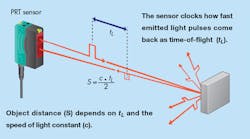Pulse-ranging-technology (PRT) sensors measure how far away objects are much like radar. During operation, a PRT sensor emits bursts of light that bounce off the object of interest and come back to the sensor. The sensor’s processor clocks the light’s time of flight (TOF) and calculates distance to the object.
Other photoelectric TOF sensors emit continuous light beams, comparing the phase of light waves they emit to those of returning light waves and calculating distance based on the difference in phase shift. PRT sensors outperform these other sensors in three ways:
- Longer range: A PRT sensor’s pulsed laser diode accepts more electrical current than laser sources that are continuously on, so they emit higher-intensity light. In fact, a PRT sensor’s light can be 1,000 times more intense than that from other sensors, so they stably detect objects from 300 m or more.
- Safe for eyes: PRT sensors are off for longer than they are on. So, though the light is intense, PRT sensors actually emit less power per unit time than sensors using continuous light beams. Therefore, many PRT sensors are certified Class 1 “eye-safe” laser products.
- Immune to noise: Sunlight, lighting, and even other nearby photoelectric sensors do not interfere with PRT sensors. Pulsed light is easy to differentiate so it helps PRT sensors eliminate crosstalk and interference. On the other hand, photoelectric sensors that use continuous beams find it difficult to differentiate their light from stray sources.
PRT sensors are typically used in continuous-measurement applications such as monitoring stack heights of metals; measuring the fill heights of containers; positioning products or loads; and preventing crane, gantry, and conveyor collisions. The sensors convert distance measurements to analog signals or streams of binary digits via IO-Link, Ethernet, or Profibus.
PRT sensors can also function as simple presence sensors. In warehouses, they can verify rack occupancy; detect panels or stacks within a defined window; check forklift-truck height; and tell when rolls or spools are full or empty. Plus PRT sensors let designers set the range at which to detect objects.
Finally, the PRT sensors detect objects with the mm-range accuracy of triangulation-based photoelectric sensing, but they are not limited by the geometrical layout of optics, so they have longer operating ranges. They also match the accuracy of ultrasonics but are faster and can detect objects at longer distances.
Michael Turner at Pepperl+Fuchs provided information for this column.

